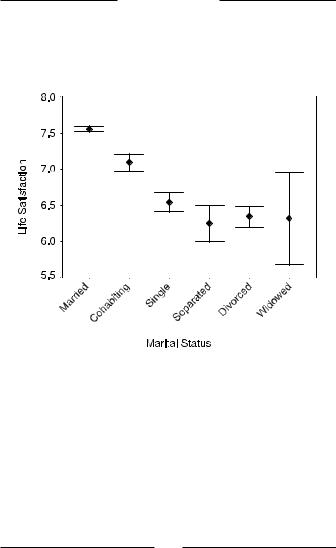
Books on Happiness / Happiness_ The Science Behind Your Smile
.pdf
LOVE AND WORK
that money brings pleasures with it. The higher social classes do have more money, and thus, in the NCDS, there is a modest correlation between income and life satisfaction. However, the social class scale reflects more than just income. It is also a measure of level of education, the likelihood of being able to choose one’s work, status relationships in the workplace, and participation in non-work leisure activities. If you control statistically for income differences, there is still a relationship between life satisfaction and social class. If you control for social class, there is almost no relationship between income and life satisfaction. This suggests that it is the non-income benefits of being in a higher social class that bring increased satisfaction.
The relationship, or rather non-relationship, between income and life satisfaction is one potential explanation for a striking but consistent finding. Over the last fifty years, per capita incomes in developed countries have increased several-fold, and the increase in average happiness within these countries has been absolutely zero. For example, between 1970 and 1990, average incomes in the USA rose by 300% in real terms. There was no corresponding increase in average wellbeing. There is, then, a paradox. Many studies have shown a weak but consistent relationship between income and happiness at any given moment, but as
72

LOVE AND WORK
everyone’s income increases over time, happiness does not follow suit.
There are two possible reasons for this. One is, as mentioned earlier, that the felicitous thing about being in the higher social classes is not to do with income at all, but with some other factor. Although everyone’s income has increased strikingly, the gains have been mere increases in material purchasing power, and have not actually transformed people’s experience of security, meaningful goals, freedom, and so on. Although a janitor today is richer in real terms than a doctor of thirty years ago, he is still a janitor, and still has as little choice about where, when, and what he does as he ever did. The other, related possibility, is that in judgements of satisfaction, what matters above all is what one has relative to what everyone else has got.
There is evidence suggesting that both of these effects are real. Numerous studies have shown strong effects of relative rather than absolute wealth on satisfaction. As for autonomy, in the NCDS, the respondents were asked various questions about their feeling of control of their lives. Fewer than 10% of the Class Is felt that the statement ‘I never really seem to get what I want’ better reflected their experience than the statement ‘I usually get what I want out of life’. Among the Class Vs, the proportion was 34%. Ninety-six per cent of
73

LOVE AND WORK
Class Is felt they had control over their lives, compared to only 81% of the Class Vs. Of course, 81% is still a majority, but then, as we have seen, most people think they are pretty happy and are not about to own up to being out of control of their destinies.
The answers to questions about control over life can be added up to give a ‘personal control’ score. This score is highest in Class I and lowest in Class V, but there is a lot of variation between individuals within a class. Personal control is a much better predictor of happiness than income is (in statistical terms, it accounts for twenty times more of the variation). The importance of personal control becomes particularly clear when individuals who are in the bottom quartile of the national income distribution but nonetheless have a high personal control score are compared to those who are in the highest quartile of income but have a low personal control score. The poor but in control group score 7.85 out of ten for life satisfaction, whereas the rich but out of control group score 5.82. Thus it seems that being at the top of the social heap only makes you happy in as much as it gives you the opportunity to control your life. If you can find alternative ways of being in control of your life, then you can be just as happy even if your income is low.
The feeling of autonomy, of being able to choose
74

LOVE AND WORK
what happens next in life, is also related to health. A series of fascinating studies of British civil servants has shown that physical health and life expectancy are linked to the grade within the service that the person works at. None of the grades suffers from absolute poverty. However, as well as higher status, the higher grades have much more control over what they do in their jobs, and this explains a significant portion of their superior outcomes. People really don’t like being told what to do, whatever the material inducements.
When people get a pay rise, they are happy, even joyful. And yet we have seen that in the long term, as incomes rise, no one gets any happier. This means that there must be adaptation. That is to say, the initial euphoria must wear off as the person gets used to the new state, with the result that after some time, they return to the same level of happiness they had in the first place. The idea of adaptation was brought to the fore by Philip Brickman and Donald T. Campbell in a classic article in 1971. Later studies found that people who win large amounts of money in lotteries have only a temporary boost to their happiness. They return to their ante-ludem level of felicity in a few months, a finding that would no doubt have delighted Juvenal
75

LOVE AND WORK
and the Stoics, keen as they were on pointing out the foolishness of human desires.
Brickman and Campbell created the vivid metaphor of the hedonic treadmill to explain the implacability of levels of happiness. Each time we advance towards a desired state, we quickly get used to the new terrain, and thus have no more satisfaction there than we did in the previous location. As a result, we work hard at running but never get anywhere. Los Angeles economist Richard Easterlin gives one of the clearest demonstrations of the hedonic treadmill at work. Participants in an ongoing social survey of a cross-section of the American population were asked to go down a list of the major consumer goods that people invest their money in (house, car, television set, travel abroad, swimming pool, second home, and so on). The first time, they were asked to tick off which of those goods formed part of their ideal of the good life (the life they would like to have). They were then asked to go down the list again and tick off which of the items they actually had already. The survey was repeated sixteen years later. Over the early part of their adult lives, people go from having few if any of these big-ticket items to having several of them. The trouble is that their ideal of what would be needed for the good life recedes at almost exactly the same rate as they advance. When they are young, a house, car, and
76

LOVE AND WORK
TV seem enough. Later on, a holiday home comes to seem just essential. Over the 16 years, people went from having 1.7 to having 3.1 items, and meanwhile the good life went from consisting of 4.4 items to consisting of 5.6 items. They were still 2 items short of where they wanted to be, just as they had been at the beginning.
This inflation goes on through the life-course, though both the attainment of new goods and the gannet-like advance of aspiration mellow in older years. As a result, in lifestyle goods, essentially no advance is achieved by accumulation, at least on average.
How do differences in life satisfaction levels between nations fit into this picture? Recall that the differences across nations are not huge. All countries basically fall in the 5 to 8 window on a ten-point scale. However, there are differences, and the Gross National Product, or wealth level, of the country, is a good predictor of these. This relationship must be squared with the apparently contradictory finding that looking within the developed countries through time, as national income has gone up, national happiness has stayed the same. It may be that increasing wealth only matters to a certain point. Some cross-sectional studies have found that the curve of national well-being against national income rises steeply when countries are poor, but levels
77

LOVE AND WORK
off once countries have reached a modest level of affluence. A related possibility, again, is that income is not in itself productive of happiness.
Looking across the world, national income tends to be positively related to other more nebulous variables such as political freedom, human rights, equality, low crime rates, and so on. These may be the things that actually matter. Some of them, like democracy and human rights, are achieved at a certain level of economic development and then are essentially static against further income growth. For others, like crime or social insecurity, economic growth initially makes great inroads into them, but later, as all the avoidable evils have been avoided and only the unavoidable ones remain, further growth has ever-diminishing effects. All this would mean that the curve of national well-being against Gross National Product would flatten off at a certain point, a point which the developed economies have largely reached.
One of the most reliable findings in studies of wellbeing is that people who are married score more highly than those who are not. The NCDS is no exception. As Fig. 3.2 shows, those who were married were considerably happier than those who were not. Those cohabiting were a little less happy than the married ones, with
78

LOVE AND WORK
Fig. 3.2 Life satisfaction in contemporary Britain by marital status at age 42. Data fram the 2000 sweep of the National Child Development Study.
79

LOVE AND WORK
those who had never married coming in third. Least happy of all, on average, were those who had been married but were divorced, separated, or widowed.
The information on which the figure is based was collected in 2000, when the NCDS cohort was 42 years of age. Most of the participants were married by this time, and theirs was a generation where marriage was the norm. The patterns might not hold so strongly in a group where marriage is not so widespread and culturally expected. Nonetheless, these are relatively strong effects. Marital status accounts for much more of the variation in life satisfaction than social class does. Moreover, essentially the same pattern is found in numerous independent studies.
There has been much interest in the idea that men and women might benefit to differing extents from marriage. Studies of life satisfaction give only slight support to this idea. In the NCDS, the excess happiness of married women over never-married ones was 1.05 points, whereas the comparable gap for men was 0.97 points. The divorced-married gap was 1.28 for women compared to 1.16 for men. The sex differences are modest, especially when you allow for women’s greater emotional expressivity in general. All in all, it looks like marriage, or the lack of it, has similar effects for women and for men.
80

LOVE AND WORK
Before we jump to the conclusion that Dr. Freud was right about love, and good biblical love at that, being the key to happiness, we ought to consider the patterns a little more deeply. It has often been claimed that these findings show that marriage is the most enduring path to happiness. However, it could equally well be that happiness is the most enduring path to marriage. Extroverts tend to fall into romantic relationships more easily than introverts, and they tend to be happier, too. On the other hand, those who are constitutionally neurotic tend to be unhappy, and they are at a heightened risk of divorce. Thus, part of the effect is due to people who are happier at the outset getting married more, and staying married longer, rather than matrimony bringing joy.
There seems to be consensus that this cannot be the whole explanation, but the only way to know for sure is to follow the same individuals through time as they go from single days to matrimony (or not). This was the strategy taken by a German study that recontacted the same panel of 24,000 people yearly for up to 15 years. The study showed that, indeed, those who got married were happier at the outset than those who did not. However, this is not the whole story. The transition to marriage in an individual was also associated with a substantial increase in happiness over and above whatever
81
